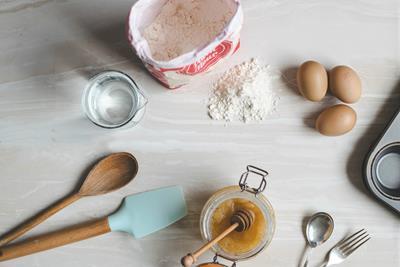
Wednesday August 28, 2019
 Education
Education
Cooking with cannabis can involve a bit more chemistry than amateur chefs are used to. In addition to making a tasty treat, there are a host of pot-related variables to consider, which means there are a lot of things to go wrong. Never fear, PotGuide is here. We’ve compiled some useful tips to help you avoid mistakes and guide you towards better-baked bliss. Consider this your cheat sheet for weed treats.
Understanding Decarboxylation
For the most part, humans are unable to get high from ingesting raw cannabis. THC, the primary cannabinoid responsible for the high experience, exists on raw buds as THCA. THCA can be absorbed by humans, but has no euphoric effects. In order for THCA to become THC we can ingest (and experience a high from), it must first undergo a process called decarboxylation (often referred to as “decarbing”).
Base cannabinoids are volatile molecules, and will change with exposure to heat and light. When we decarboxylate cannabis, we are taking control of this process to create THC from THCA. Too much heat, however, and the THC will degrade into other cannabinoids and compounds.
Decarboxylation is simple for cannabis flower: grind the buds, then spread evenly on a baking sheet with parchment paper. Bake at roughly 240°F for 45 minutes to an hour. Add or subtract a little heat and time depending on the amount of cannabis being cooked. For larger amounts, aim towards the higher end, and for smaller, lower. For other infusion methods, such as making cannabis butter, aim for a similar temperature range, though it will usually require longer simmering for full absorption (about 4-8 hours).
Avoid Cooking Out the Cannabis
Decarbing is necessary to make edibles, but beware, if too much heat is applied, the THC can be effectively cooked out. Exceeding temperatures of 351°F will begin to sacrifice THC content, and studies have shown that heating above 392°F will introduce unwanted toxins such as benzene, toluene, and naphthalene.

So long as your recipe stays below 351° F, you’re in no danger over-decarboxylating your edibles. Still, be aware that recipes vary, and some brownie instructions call for temperatures of 375° to 425°F. Be sure you aren’t wasting your product by overheating the batch and cooking out your THC.
Proper Edible Dosing
To calculate dosage, there are a number of dosage calculators to be found online. However, perfectly even dosing is rare, even under ideal conditions. As a result, many budding cannabis chefs underestimate the potency of their edibles, or forget to account for uneven distribution.
When making edibles at home, be aware that first-time batches might not be dosed as intended. Go slow at first.
Be sure to sample different parts of the end product before consuming in unknown settings or offering your edibles to others. The most reliable method is to test the finished product, although amateur chefs rarely have access to professional labs. If you are unsure about the potency of a batch, remember this saying, “when in doubt, assume the maximum amount.”
Fat Content and Uptake
THC needs to attach itself to another compound in order to become bioavailable and enter the bloodstream. THC is not water-soluble (meaning it won’t naturally mix with water), but is fat-soluble. Thus, edibles must have some fat content to be effective.

For ideal uptake, be sure to have something in the recipe for cannabinoids to latch on to. If an edible has little or no fat content, just nibble something that does. Fats can come a variety of sources, from cheese to avocados, so consider something light that won’t delay uptake.
Avoiding a Hashy Taste
An excess of cannabis plant material in the ingredients can result in a “weedy” or “hashy” taste. This can be a result of not properly straining butter or oil and leaving cannabis flower in the end product. Overall, try minimize starchy plant matter in the end food product by straining your butter or oil, and try to keep infused ingredients in proper proportion. While many don’t mind a hint of the plant’s natural essences, no one wants a salad in their cookie.
Using Reclaim to Make Edibles
Many a stoner will attest that excellent edibles can be made using reclaim from concentrate or post-vaped flower. Ideally, either will still contain a partial amount of harvestable cannabinoids, and some tests show that reclaim concentrate retains a significant percentage of THC. However, edibles made this way will be a little different than those made from fresh cannabis preparations.
THC degrades into CBN when heated. As a result, both reclaim and post-vaped flower have higher levels of CBN, and are more likely to make CBN-heavy edibles. CBN isn’t necessarily bad, but is responsible for some of the drowsy effects of cannabis. Edibles made from recycled product might not ideal for a night on the town, but can make for a potent sleep aid with heavy body effects.

Using reclaim or vaped flower is not a mistake in itself, but if you’re finding that edibles from these sources hit a little heavier than you’d like, try switching up your source material to see if it makes a difference.
Final Thoughts
The chemistry of DIY edibles may seem daunting at first, but with a little practice, anyone can master potent, tasty treats. Home-baking edibles can be especially helpful for medical patients who have strict dietary needs, and tends to be more cost-effective than purchasing from a dispensary. A certain degree of trial and error is likely, but keep at it and these tips will steer you towards culinary bliss.
Have some excellent canna-baking tips? Share your stories of success (or failure) in the comments below.
Photo Credit: Calum Lewis (license)







